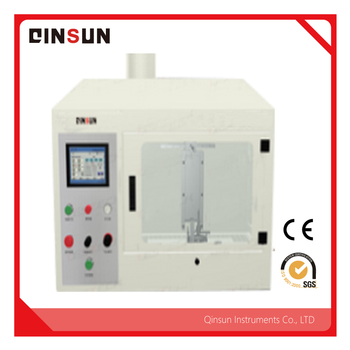ISO11925-2 Combustion Chamber for building materials

ISO 11925-2 is a specific standard that provides the test method for assessing the reaction to fire behavior of building materials subjected to direct impingement of flame. This standard focuses on the use of a combustion chamber for conducting tests. In this context, a combustion chamber refers to a controlled environment where building material specimens are exposed to a direct flame to evaluate their combustibility characteristics. Here is an explanation of ISO 11925-2 and the key aspects related to the combustion chamber.
1. Test Specimens: ISO 11925-2 outlines the requirements for test specimens used in the test procedure. This includes specifications for the dimensions, conditioning, and preparation of the specimens to ensure consistent and accurate results. The standard provides guidance on the types of materials that can be tested in the combustion chamber, such as various building products and components.

2. Combustion Chamber Design: ISO 11925-2 specifies the design and construction of the combustion chamber. The chamber should be made of non-combustible materials and have suitable dimensions to accommodate the test specimens. It should also include provisions for the controlled supply of fuel and extraction of combustion gases so that the chamber can maintain the desired test conditions.
3. Test Conditions: The standard defines the specific test conditions that should be maintained within the combustion chamber during the test. This includes parameters such as heat flux, duration of exposure, and conditions for ignition. The combustion chamber should be capable of closely regulating these conditions to ensure accurate and repeatable test results.
4. Ignition Source: ISO 11925-2 specifies the ignition source that should be used in the combustion chamber. This typically involves the use of a gas burner or other suitable flame source. The ignition source should be positioned in such a way that it produces direct impingement of flame on the test specimen, simulating real-world fire scenarios.
5. Instrumentation and Measurements: The standard outlines the instrumentation requirements for the combustion chamber. This includes temperature sensors, heat flux meters, gas flow meters, and other devices necessary for monitoring and recording key parameters. These instruments should be properly calibrated to ensure accurate measurements throughout the test.
6. Data Acquisition and Analysis: ISO 11925-2 emphasizes the importance of data acquisition during the test. Relevant parameters such as temperature, heat flux, and gas flow should be continuously recorded to evaluate the behavior of the test specimen under the applied flame exposure. These data points are crucial for later analysis and comparison.
7. Test Report: After conducting the test in the combustion chamber, ISO 11925-2 requires the generation of a comprehensive test report. The report should include details on the test conditions, instrumentation used, test results, and any observations made during the test. The report should also provide an analysis of the specimen's behavior, including flame spread, heat release, and other relevant reaction-to-fire characteristics.
By following ISO 11925-2, the use of a combustion chamber allows for standardized testing of building materials' reaction to fire. The controlled environment provided by the chamber helps provide accurate and comparable data on the combustibility properties of different materials. This information is essential for ensuring the fire safety of construction materials and aiding in the development of fire-resistant building practices.
Any interested customers, please leave a message online, we will provide a quotation within 24 hours, welcome to inquire!
2023-09-04 11:41

